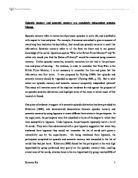Semantic memory is the part of the memory that stores information, such as a car has four wheels, the sky is blue, and it becomes dark at night. Because it is part of long-term memory, McNamara (2005), highlights that it can take a while before some of the information is stored or encoded in semantic memory.
The Canadian Institute of Health Research (2009), reports that semantic memory also includes the meaning of words, the functions of objects, and their color and odor. Further, semantic memory is said to contain the rules and the concepts that allow individuals to construct mental representations of the world without any immediate perceptions.
In nature of semantic memory is abstract as well as relational; it is also associated with the meaning of verbal symbols, which makes it directly related to language. Although, Goldstein (2009), states that semantic memory is what allows individuals to communicate with language, this connection can be best understood by a review of the basic functions of language.
Basic functions of language
Newmeyer (2000) concludes that language has three basic functions. The first function is an informative function, which is the communication of information. This function is important for logic in that it affirms or denies the validity of claim; it also describes the world and reasons about it. A determination of truth value associates with the informative function. The second function of language, according to Newmeyer (2000), is expressive. This function allows the communication of an individual’s feelings and the expression of that individual’s attitudes to others. The function can also evoke feelings in others. Poetry can be an example of expressive function. The third function of language is directive. This is a command and request function, for example, “Please close the door” or Could I ask you to please close that door?” It is important to note that in any given communication; more than one function of language is taking place.
According to Halbeisen (2010, p. 1), “the connection between semantic memory and language can be found in the fact that language involves a highly complex set of rules, which secures human beings position at the top of the taxonomic scale.” In other words, as noted earlier, semantic memory has to do with the meaning of verbal symbols, and with rules, in which are highly used in language. Moreover, because it was noted that a function of language is to describe the world and reason about it and semantic memory contains descriptions of the world, the connection between semantic memory and this particular language function is strong.
Stages of language production and their relationship to semantic memory
Robinson-Riegler (2008), defines language production as the translation of thought into speech, a process said to require a diverse range of mental operations with four discrete stages: conceptualization, planning, articulation, and self-monitoring. When people conceptualize, they are said to be involved in determining what they specifically want to say, which involves planning precisely what elements of the conceptualization to transfer to speech. Articulation involves the production of the sounds of language, and self-monitoring is a reflective function said to occur after articulation or the speech. Regarding the relationship of semantic memory to language production, Halbeisen (2010), indicates that research on this connection tends to focus on errors in speech because the relationship of semantic memory to language production is affected not only by what to say and how to say it but also by the context, the event, and even the culture. In other words, the relationship is fairly complex.
An example of the nature of ongoing research investigating language production and semantic memory can be seen in a study conducted by Kuperberg (2008), who examined language production and its relationship to semantic memory in schizophrenics known for their disorganized speech and thought process. In the study, Kuperberg (2008), found that automatic activity in semantic memory was qualitatively different in schizophrenics compared to patients, which did not have disordered thought processes. It was concluded that semantic memory is called upon to play a larger than normal role in the language production of schizophrenics than it is with people not thought disordered, What this study shows is the direct connection between the coherent production of language and semantic memory. However, the exact nature of the relationship that describes this connection is yet to be determined. As noted by Goldstein (2009), there are many theories or conceptualizations but no one theory stands out as the definitive explanation. Rather, each theory has some support.
Conclusion
The human brain is a warehouse of information and knowledge that allows individuals to acquire, store, retain, and retrieve information such as language. The mind is still a mystery and complex in the world of psychology, but with further investigation and research, the nature between semantic memory and language among other types of memory can be determined that can help individuals unfortunate to communicate.
References
Antonucci, S. M., & Reilly, J. (2008, February 29).Semantic memory and language
processing: a primer. U.S. National Library of Medicine, National Institutes of Health
Retrieved on May 31, 2011 from http://www.ncbi.nlm.nih.gov/pubmed/18348088
Canadian Institute of Health Research (2009). Memory and learning. Retrieved on May 30, 2011
from http://thebrain.mcgill.ca/.
Goldstein, E.B. (2009). Sensation and Perception. (8th ed.). Belmont, CA: Wadsworth
Publishing
Halbeisen, D. V. (2010). The inter-relatedness of semantic memory and language. Retrieved on
May 30, 2011 from http://halfiron.net/pubs/interrelatednessofsemantic.doc.
Kuperberg, G. R. (2008). Building meaning in schizophrenia. Retrieved from Clinical EEG and
Neuroscience, 39 (2), 99-102. Retrieved on May 30, 2011 from
http://www.ncbi.nlm.nih.gov/pubmed/18450178
McNamara, T. P. (2009). Semantic priming: Perspectives from memory and world recognition.
New York: Psychology Press. Retrieved on May 30, 2011 from
http://www.worldcat.org/title/semantic-priming-perspectives-from-memory-and-word-recognition/oclc/57557721
Newmeyer, F. J. (2005). Language form and language function. Cambridge, MA: The MIT Press
Retrieved from http://mitpress.mit.edu/catalog/item/default.asp?ttype=2&tid=7654
Robinson-Riegler, G., & Robinson-Riegler, B. (2008).Cognitive psychology: Applying the
science of the mind. (2nd ed.) Boston: MA: Pearson/Allyn and Bacon.







